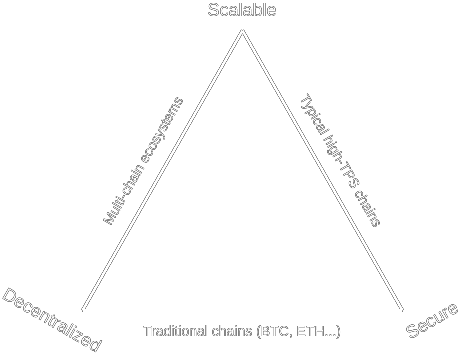The Litheum team often talks about the Blockchain Trilemma, any chain that claims to be able to scale should have a solid grasp of the concepts behind it and people often bring it up.

The Blockchain Trilemma was originally conceptualized by Vitalik to advocate for sharding in his blog post “Why sharding is great: demystifying the technical properties”.
The Trilemma states that a blockchain must choose two of three properties: Security, Decentralization, and Scale. In this post, we’d like to explore the reason scale is part of the Trilemma and how it relates to block size limits.
The Origin of Scale in the Trilemma
Vitalik defines Scalability like this:
Scalability: the chain can process more transactions than a single regular node (think: a consumer laptop) can verify.
This is a workable definition, but it doesn’t really explain why the number of transactions can’t be increased. Even a modest laptop should be able to process billions of transactions per day… A single CPU core can verify maybe 10k signatures per second, 32GB of RAM could store perhaps 1 billion outputs. Blockchains operate at megabytes per hour but a single $100 network card can handle gigabits per second.
To understand why scaling is usually dangerous, we need to recognize that typical blockchains incentivize (and thereby decentralize) only a subset of their functions, not all of them. The example I like to give is wallet synchronization. In a typical blockchain a wallet might request its outputs or other data from one node, then sign that data for a transaction and send it to a second node which relays it to the rest of the network. Typically, a 3rd node will then include the transaction in a block and collect the fee. The first two nodes do critical work for the chain but don’t get paid for it. There are many RPCs that typical blockchains don’t incentivize besides wallet synchronization; for example, block propagation, transaction propagation, and peer discovery are some of the most critical.
Vitalik identifies chains which don’t scale:
Traditional blockchains — including Bitcoin, pre-PoS/sharding Ethereum, Litecoin, and other similar chains. These rely on every participant running a full node that verifies every transaction, and so they have decentralization and security, but not scalability.
At Litheum we see things slightly differently. The origin of the danger of scale is not created from a reliance on “every participant running a full node that verifies every transaction”. The danger is from the fact that unincentivized costs expand. Take, for example, the wallet synchronization RPCs we discussed above. The cost of providing those RPCs is quite small compared to the cost of hashing. If a Bitcoin Miner provides these (which they typically do), they likely wouldn’t notice since 99% of their cost of operation is spent on Sha256 hashing and other things. But if the blockchain was to get 1000 times larger, they would become very noticeable. The problem is that the incentivized work, hashing, does not grow along with the size of the blocks (and therefore the size of the network) but the un-incentized work does. The cost of creating a block is nearly the same whether a miner is hashing an empty block or a full one. But the cost of synchronizing 10 billion wallets is 10000 times greater than synchronizing a million. The same problem exists for a Proof-of-Stake consensus.
There’s also a disconnect between the cost of unincentivized RPCs and the value they provide. If someone puts some junk data on the chain, it’s pretty much worthless. No one cares about an overly compressed photo of Tiananmen square on the chain, and, in fact, miners have no reason to keep it in memory or provide the data at all… What EVM data is extremely valuable, likely to be needed to validate a transaction soon, and which is just some dust, is hard to tell, and there’s no way to distinguish the two economically.
The Ethereum community is suddenly seeing an effect of this problem, although they might not fully comprehend it’s origin. Validators are being asked not to run their servers in the cheapest way because it will centralize the chain. Volunteers are needed! Now imagine if the blocks were made 100x larger. Would validators be willing to run AWS instances that cost 100x more than what they’re paying now?
Volunteerism is needed to maintain decentralization in a typical blockchain, someone needs to provide those unincentivized RPCs. This is critical to understanding the Trilemma and how Scale, Decentralization, and Security effect each other.
We’ll revisit the idea of un-incentivized RPCs in parts 2 and 3 where we’ll discuss the other parts of the Trilemma: Security and Decentralization. Subscribe to follow along.
- Twitter: https://x.com/LitheumOfficial
- Telegram: http://t.me/litheumofficial
- Discord: https://discord.gg/2GJTW7TC
We look forward to achieving True Decentralization together!
Clayton Rabenda Litheum







